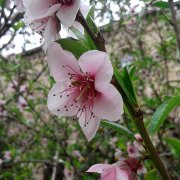Care of the tree Prunus persica or Peach |
|
The genus Prunus, family Rosaceae, comprises 200 species of trees and shrubs native to temperate regions of the Northern Hemisphere. Some species are: Prunus persica, Prunus mahaleb, Prunus lusitanica, Prunus laurocerasus, Prunus incisa, Prunus dulcis, Prunus cerasifera, Prunus avium, Prunus domestica, Prunus spinosa, Prunus armeniaca, Prunus serrulata, Prunus cerasus. Common name: Peach. This species is native to China. They are small trees or shrubs with twisted and highly branched stems that can reach 8 meters (26.24 feet) in height. The leaves are deciduous, alternate, lanceolate with a serrated edge. The most interesting are its abundant axillary flowers that appear before the leaves and can be white or pink (depending on the variety). They bloom in spring. The fruit is known as peach, which in ornamental varieties is usually a small fruit. Peach is used as fruit trees (horticultural varieties), as isolated specimens or in small groups. Prunus persica needs full or well-lit exposure. In winter they need a period of rest at 7-9 ºC (44-48 ºF). It resists frost. The soil should be light, well drained with coarse sand, and contain organic matter. Peach does not resist calcareous or clay soils. Transplantation or planting is done in autumn. Water frequently in summer (without flooding) and reduce watering the rest of the year considerably. Fertilize in late winter with compost and mineral fertilizer in early spring to promote flowering. Prune lightly in late winter to keep it compact. Prunus persica can be attacked by aphids, by insects and by chlorosis. The propagation of ornamental varieties is complicated (grafting); Buy new plants from nurseries, garden centers, or plant stores. |
Images of the tree Prunus persica or Peach |
Find plants
Prunus persica or Peach | Care and Growing
© 2026 FavThemes



